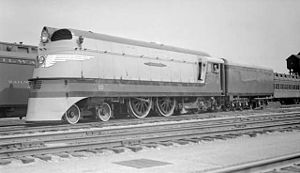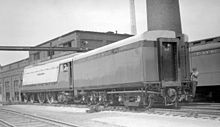- Milwaukee Road class A
-
Milwaukee Road class A 
Milwaukee Road class A #2 at Chicago, Illinois on September 25, 1935. Power type Steam Builder American Locomotive Company Serial number 68684, 68685, 68729, 68828 Build date May 1935 (2), May 1936, April 1937 Total produced 4 Configuration 4-4-2 UIC classification 2′B1′ h2 Gauge 4 ft 8 1⁄2 in (1,435 mm) Driver diameter 84 in (2,134 mm) Length 88 ft 8 in (27.03 m) Weight on drivers 144,500 lb (65.5 tonnes) Locomotive & tender
combined weight537,000 lb (243.6 tonnes) Fuel type Oil Fuel capacity 4,000 US gal (15,000 l; 3,300 imp gal) Water capacity 13,000 US gal (49,000 l; 11,000 imp gal) Boiler pressure 300 lbf/in² (2.07 MPa) Heating surface:
Firebox69 sq ft (6.4 m2) Heating surface:
Total3,245 sq ft (301.5 m2) Superheater area 1,029 sq ft (95.6 m2) Cylinders Two Cylinder size 19 × 28 in (483 × 711 mm) Tractive effort 30,685 lbf (136.49 kN) Career Milwaukee Road Number in class 4 Number 1 – 4 Retired 1949–1951 Disposition All scrapped The Milwaukee Road class A comprised four (#1–#4) high-speed, streamlined 4-4-2 "Atlantic" type steam locomotives built by ALCO in 1935-37 to haul the Milwaukee Road’s Hiawatha express passenger trains. They were among the last Atlantic types built in the United States, and certainly the largest and most powerful. The class were the first locomotives in the world built for daily operation at over 100 mph (160 km/h), and the first class built completely streamlined, bearing their casings their entire lives. Although partially supplanted by the larger F7 "Hudsons" from 1937, they remained in top-flight service until the end. Locomotive #3 was taken out of service in 1949 and cannibalised for spares to keep the other three running until 1951. None survive.
History
They proved highly successful, indeed exceeding design goals. Designed for keeping a 6½ hour schedule between Chicago, Illinois and the Minneapolis-St. Paul "Twin Cities", the class proved themselves capable of handling nine cars on a 6¼ hour schedule. The only change over the years, except bumps and dents in the casing, was the addition of a Mars Light beneath the winged emblem on the nose in 1947.
When introduced, they hauled the fastest scheduled express trains in the world, with average speeds over the whole run, including stops, of greater than 80 mph (130 km/h). Regular running at 100 mph or greater was required to keep these schedules; the class A locomotives were designed to cruise at over 100 mph and be able to achieve 120 mph (190 km/h). A recorded run with a dynamometer car behind the locomotive was made on May 15, 1935 by locomotive #2 between Milwaukee, Wisconsin and New Lisbon, Wisconsin. Over a 14-mile stretch the speed of 112.5 mph (181.1 km/h) was recorded. This was the fastest authenticated speed reached by a steam locomotive at the time, making #2 the rail speed record holder for steam and the first steam locomotive to top 110 mph (180 km/h). There are reports, without physical evidence or accurate records, that these locomotives could exceed 120 mph. Such speeds would have placed the class A in contention with the LNER Class A4 and German BR 05 for the crown of fastest steam locomotive until that time, but so far no records have been unearthed. The successor Milwaukee Road class F7 was even more powerful, with a claimed top speed of 125 mph (201 km/h).
The design was fairly conventional but unusual in some aspects. One major goal was reducing reciprocating mass, which could not be completely counterbalanced. This was the reason for the high boiler pressure of 300 psi (2.07 MPa), which enabled the use of smaller, lighter pistons. The main rods connected to the first pair of driven wheels rather than the (more conventional) second; again, this reduced the reciprocating mass. The large 84-inch (2.134 m) diameter driving wheels (80-inch (2.032 m) was the standard) reduced piston speed and made high speeds less taxing on the machinery. The streamlined casings were designed to open easily for servicing; the front end contained a pair of clamshell doors to access the smokebox front.
References
- Benn, Bryan. "Fastest Steam Locomotive". http://www.germansteam.co.uk/FastestLoco/fastestloco.html#MR1. Retrieved 2006-01-09.
- Ross, Don. "Chicago Milwaukee St. Paul & Pacific: Class A 4-4-2 Hiawatha Atlantics". Don's Rail Photos. http://donsdepot.donrossgroup.net/dr038.htm. Retrieved 2006-01-09.
- Hollingsworth, Brian and Cook, Arthur (2001). The Great Book of Trains. Osceola, Wisconsin: MBI Publishing. ISBN 0-7603-1193-5.
- Reed, Brian (1972). Loco Profile 26 - The Hiawathas. Windsor, Berkshire, UK: Profile Publications Ltd.
- Edson, William D. (Spring 1977). "Milwaukee Road Locomotives". Railroad History (Boston, Massachusetts: The Railway and Locomotive Historical Society, Inc.) (136): pp. 28–129.
Categories:- Streamlined steam locomotives
- Milwaukee Road locomotives
- ALCO locomotives
- 4-4-2 locomotives
- Passenger locomotives
- Railway locomotives introduced in 1935
- Steam locomotives of the United States
Wikimedia Foundation. 2010.

